How is the harvesting of corn for grain: terms and stages of the process, further processing and storage of the crop
Corn used for food, for the production of starch and molasses, as feed for farm animals. The crop yield is high, on average 32-37 centners of grain per hectare. How to harvest and store corn in order to preserve the harvest as long as possible, we will tell in the article.
The content of the article
Terms of harvesting corn for grain
The harvesting of corn for grain begins when the physiological (full) ripeness of the seeds is reached.
Harvesting takes about two weeks. The timing of the start of cleaning is calculated so as to have time to complete the work before the onset of prolonged rains and frosts.
Frozen seeds lose their germination. The collection of wet corn leads to the spread of fungal diseases, which reduces the market value of the raw material.
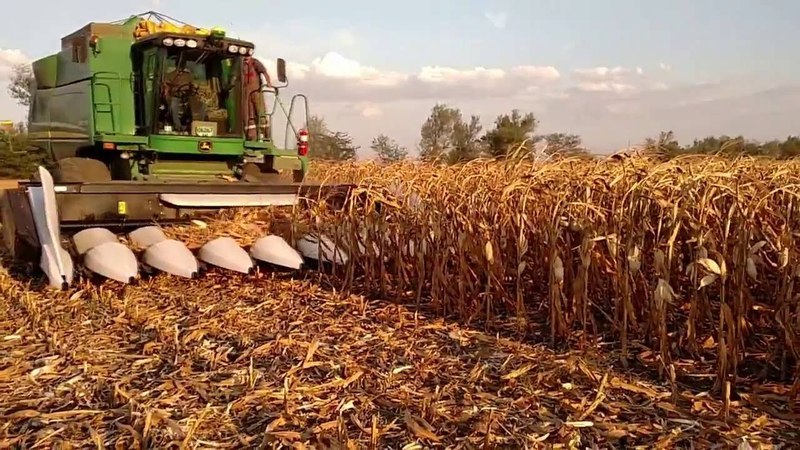
Maturity stages
There are four stages of ripeness for corn:
- Dairy - characterized by a liquid endosperm consistency. When pressed, a milky white juice is released. Comes 15-20 days after fertilization. The moisture content reaches 80%.
- Wax - begins about 26 days after the start of pollination. Endosperm at first resembles soft dough, then soft cheese and gradually thickens. In fruits, the amount of sugar decreases, starch and dextrin are formed.
- Vitreous - lasts from 36 to 48 days from the start of seed formation. The grains begin to dry out, have a slightly wrinkled appearance.
- Full - usually occurs 55 days after pollination. The grains become hard and brightly colored. Leaves and cob wraps turn yellow. Its weight at this stage reaches its maximum.
Determining the timing of the beginning of the harvest
The optimal time for harvesting corn is to cut off the supply of nutrients. During this period, the seed weight is maximum, the dry matter content reaches 60% and more. The reference point for the start of harvesting is the appearance of a "black point" at the base of the seed.
If summers are cold, power outages are slower, so the black point factor becomes unreliable. In this case, the sum of effective temperatures after the flowering of female inflorescences is taken into account to make a decision to start harvesting. The biological maturity of corn grains occurs when this indicator is 800 ºС.
reference... The sum of effective temperatures is the sum of the average daily air temperatures exceeding the lower temperature limit of plant development for the considered growing season.
Harvesting begins earlier (with grain moisture content of 40-45%), if there is a risk of worsening weather conditions (early frosts, prolonged rains). When the fruit dries to a moisture content of 18-20%, losses increase.
Advantages and disadvantages of early and late harvest
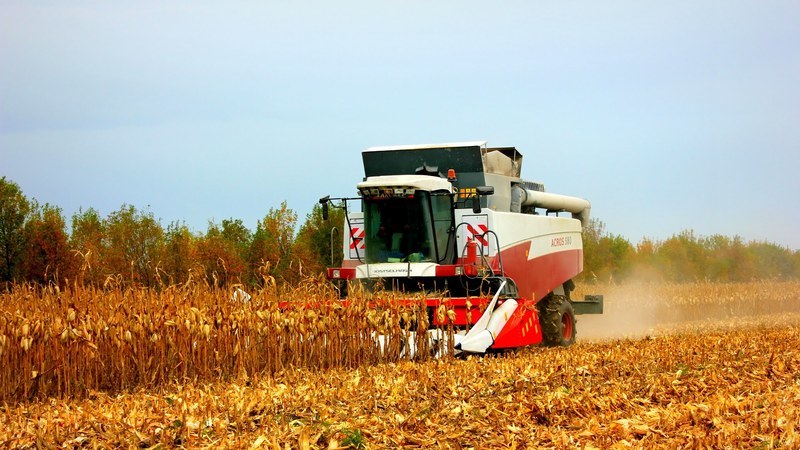
| Benefits | disadvantages | |
| Too early |
|
|
| It's too late |
|
|
Process technology
Harvesting grain corn consists of the following technological operations:
- field preparation;
- cutting and cleaning cobs;
- threshing;
- collection and grinding of plant residues.
The last three, as a rule, are carried out together on one harvesting unit.
Important! Grain must be processed within four hours of harvest. Due to the high humidity of the raw material, its deterioration occurs - the appearance of mold, fungus, rancidity.
Field preparation
At the stage of preparing the field for harvesting, the optimal direction of movement of the combines is determined. Most often it coincides with the direction of sowing. Swaths are made at the edge of the field and headlands are prepared.
Further, the width of the corrals is set: it is 6-12 times less than the length of the rut and is a multiple of the double width of the harvesting machine. It is not allowed to get the butt spacing into the grip. The number of corrals must be a multiple of or equal to the number of combines in the link.
With a rut length of more than 1000 m, transport and unloading highways with a width of 7-8 m are plowed every 500-600 m.
Combine harvesting with threshing of cobs
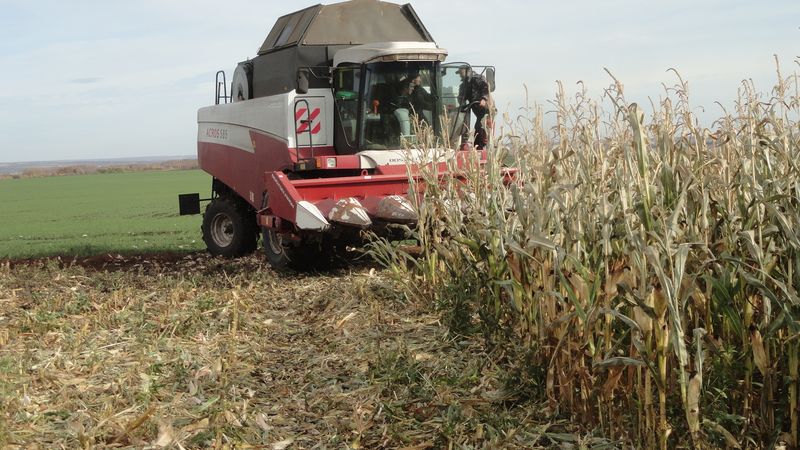
In this way, grain is harvested with a moisture content of up to 30%. Since the harvesting, cleaning of the cobs and threshing are combined in one operation, the culling of the cobs is not performed and the product is used only for forage purposes.
Self-propelled harvesters KSKU-6 are used for harvesting with threshing. The header feed chains guide the stalks into the maize pickers. The stems are pulled through the slits of the detachable plates, the ears are detached, and the cutter bar cuts the stems at a height of 15 cm from the soil surface.
The cobs are transported to the auger, which distributes them to the conveyors. The cobs are partially cleared of the remains of stems and leaves by stalk catchers installed in the upper part of the conveyors and fed to the thresher. The threshed grain through the unloading conveyor enters the harvester trolley, rods and cob wraps are dumped onto the field.
The stems are sent to a drum-type chopper. Crushed plant residues are thrown out through the silage chute into the body of a nearby machine or tractor.
Agrotechnical requirements for combine harvesting with threshing:
- grain losses behind the combine - no more than 0.7%;
- undershot - no more than 1.2%;
- crushed grain content - not more than 2.5%;
- the content of seeds in the silage mass - no more than 0.8%;
- purification degree - not less than 97%.
Combine collection of cobs
Harvesting of cobs without threshing is used for food and seed grain. This method is applicable when seed moisture is 35-45%.
The collection of cobs is carried out on combines "Khersonets-7V" or grain harvesting units with a PPK-4 attachment. The operation of these machines is similar to the operation of KSKU-6. The difference is that the separated cobs do not go to the thresher, but to the cob cleaner.
Drying and threshing of the ears takes place at stationary post-harvest processing and storage stations.
Agrotechnical requirements for harvesting cobs:
- the content of peeled ears in a heap is not less than 95%;
- the proportion of broken ears - no more than 5%;
- heap purity - not less than 99%.
Most of the harvesters are designed for sowing corn with a row spacing of 70 cm and a plant spacing of at least 20 cm.
Modern harvesters ensure the collection of the entire biological crop up to 20 tons per hectare.
Post-harvest processing
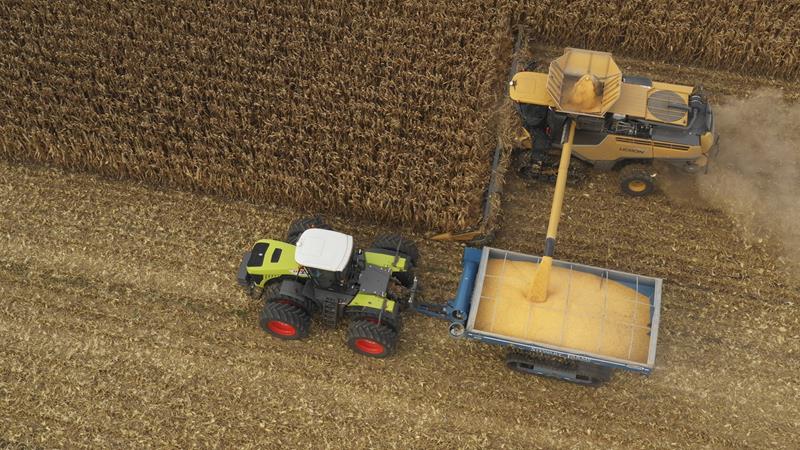
Post-harvest grain processing includes cleaning and drying.
Cleaning
Cleaning is subdivided into:
- preliminary - clean the freshly harvested mass or wet before drying;
- primary - all types of impurities are separated and the main grain is isolated;
- secondary - sort the product into fractions.
Air sieve separators are the main equipment for cleaning raw materials. All light organic impurities, too small and too large grains are separated.
The units consist of aspiration channels and a set of sieves with different mesh sizes. During the cleaning stage, movements are minimized, especially through high-performance elevators and augers, in order to prevent mechanical damage to the product.
The capacity of modern equipment for cleaning is 10-15 tons per hour, for sorting - 20 tons per hour.
Drying
Depending on the moisture content, the harvested grain is sent for storage or processing.
At a humidity of 14-15%, corn is sent for storage, at a humidity of 15-17% - for drying or ventilation, at a higher humidity - only for drying.
Ventilation is effective for processing a product with a moisture content of 1-5% above normal. In the drying mode, the raw material is blown with warm atmospheric or slightly warmed air.
For drying, use dryers of mine, column or bunker type.
Use soft modes, grain heating is allowed:
- for forage purposes - not higher than 50 ºС;
- for starch and treacle production - not higher than 45 ºС;
- for the food industry - 35 ºС.
In addition to the temperature regime, it is necessary to ensure optimal moisture yield. For one pass through the dryer, moisture loss should be 4.5-5.5%. If the corn is not dried in one go, it is processed in several passes.
After drying, the grain must be cooled. The temperature at which it is allowed to fall asleep in corn storage should not be more than 8-10 ºС higher than the ambient temperature.
Read also:
Is it possible to eat boiled corn for pancreatitis.
Further storage
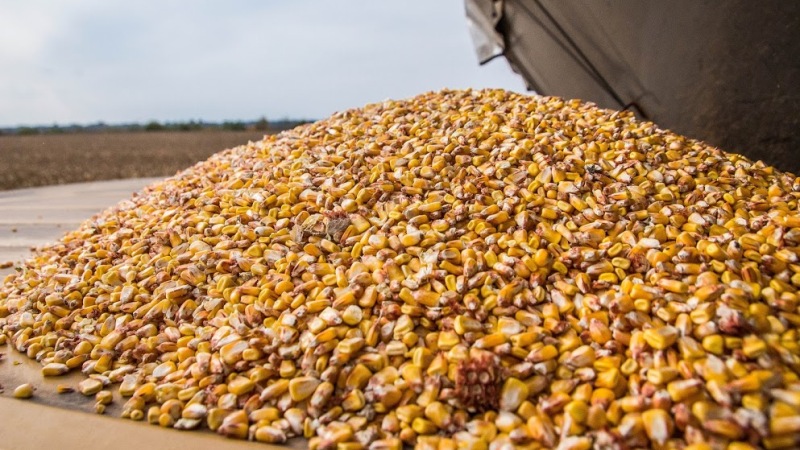
Corn grain is stored in bulk in warehouses, in silos of elevators, in bunker storages.
Combined feed grain is stored at a moisture content of 15-16%, food grain - at 14-15%.
For storage up to a year, raw materials with a moisture content of 13-14% are allowed, over one year - 12-13%.
Quality control
During the storage period, the temperature, humidity, color, smell, purity of the product are controlled. Particular attention is paid to indicators of pest and disease infestation.
The quality of corn must comply with the standards established by GOST 13634-90 "Corn. Requirements for procurement and delivery ". The standard applies to corn in grain and cobs, harvested and supplied for food, feed purposes and for processing into compound feed.
The basic norms, in accordance with which calculations are made for commercial corn grain, are given in the table.
| Indicator name | Norm |
| Grain moisture,% | 14,0 |
| Weed admixture,% no more | 1,0 |
| Grain admixture,% no more | 2,0 |
| Pest infestation | Not allowed |
Conclusion
Timely harvesting of corn helps to maintain the maximum yield. The main criteria for establishing the beginning of the harvest is the biological ripeness of the seeds.
Harvesting from the fields is done by combines The threshing of cobs is carried out by combines in the field or at stationary points. The harvested crop is stored in elevators or in special granaries. Compliance with agrotechnical standards at all stages of cultivation, collection and storage guarantees the preservation of the marketable properties of corn for a long time.